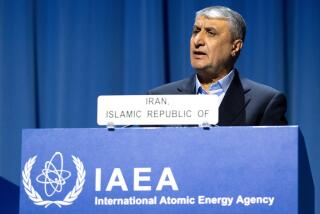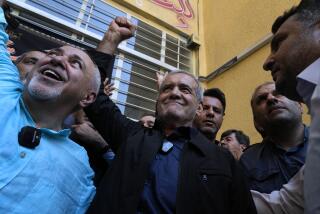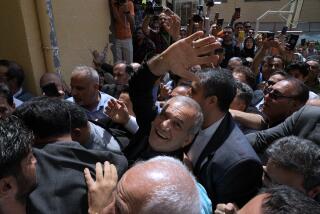Revolution? What’s in it for them?
This is an exciting time to be an Iranian American, a time for optimism, even -- provided that one also has patience.
Iran’s recent presidential elections cast gloom on hopes for quick democratic reform. But, pushed by the forces of globalization, young Iranians in Iran and elsewhere -- young Iranian American women in particular -- are nudging that nation toward genuine progress.
This is not the sort of transformation the United States is trying to impose swiftly and violently on neighboring Iraq. And U.S. policymakers, development strategists and business investors would be wise to support this fomenting of a more gentle, bottom-up evolution.
Seventy percent of Iran’s population is under age 30. An educated middle class is emerging. These overlapping groups are actively creating a civil society and counterculture -- rising literacy, more liberal sexual mores and secularization of politics.
Iran’s 150 years of troubled negotiation with modernity, including the Constitutional Revolution of 1906-11 and the Islamic Revolution of 1978-79, have prepared the nation for democracy. Iranians have become increasingly disillusioned with the “Islamist utopia” as they watch Islamists’ efforts to eliminate corruption, drug addiction and prostitution fail and unemployment and class disparity rise. Ironically, large numbers of women learned to assert their political power during the Islamic Revolution -- so they had rudimentary tools of resistance when the revolution’s Islamic government promptly ordered sex segregation and mandatory veiling, and lifted restrictions on polygamy.
Even many pro-government Islamic women embraced Muslim feminism and questioned the traditionalist interpretations of Islam. Indeed, the best-organized protest against the undemocratic electoral process and the most profound challenge of discriminatory laws took place on June 12 with the sit-in of thousands of women in central Tehran.
Today, more than 60% of university enrollment is female, and for several years now, films directed by women (such as Rakhshan Bani-Etemad’s “Under the Skin of the City”) and books written by female novelists (including Fattaneh Haj-Seyyed-Javadi’s “Drunkard Morning”) have met with popular success. Women no longer obediently follow patriarchal politicians nor are they passive consumers of the male clerics’ interpretation of Islam. Further, the enlightening effect of the U.N.-sponsored conferences on women and increasing contacts of the Muslim female elite with the global feminist networks have helped religious and secular feminists to form an assertive women’s movement for equal rights and democracy.
Meanwhile, the enthusiastic, educated, globalized Iranian diaspora is a particularly powerful influence. Communication technology -- Iran has the highest Internet usage among Muslim nations in the region -- and frequent return visits by those who left the country have spurred cultural cross-pollination that earlier generations could never have imagined.
The expatriates’ influence on family and friends in Iran has been sufficiently strong to alarm the ruling Islamists. In its early years, the Islamist government’s approach to the expatriates was indiscriminately hostile. It disseminated propaganda against them in the state-run media. Recently, however, there have been attempts to lure expatriates back to the homeland, or at least to engage them in discussions and business transactions.
Although the hard-liners still blame Iranian “outsiders” as the Western agents of “cultural onslaught,” reformers have tried to attract their support of a “dialogue among civilizations.” During the recent elections, most candidates made conciliatory comments about Iranians abroad.
This is encouraging. Despite the hostility between the U.S. government and Iran, Iranians are among the most pro-American people in the world, and Iranian Americans make up more than one-third of the 3 million or so Iranians who live outside Iran.
Yet U.S. policymakers have not recognized the even greater role Iranian Americans could play, giving far too much credence to exiled political and partisan groups that are adamant about ousting Iran’s clerical rulers by relying on U.S. military intervention -- an approach that has failed for 26 years.
There’s a better way.
California, and especially Los Angeles County, is home to the world’s largest concentration of Iranian expatriates, most of whom migrated to the U.S. during and after the Islamic Revolution. Many have succeeded in business and the professions, and are now pushing to educate Americans on the complexities of Persian culture.
UCLA, for instance, offers Iranian studies, Iranian film festivals and a Persian lecture series. In Orange County, a generous donation from micro-technology pioneer Fariborz Maseeh has allowed UC Irvine to create an interdisciplinary research center that will teach Persian history, language, culture, arts and literature. California State University campuses are beginning to offer Persian language classes. And donations from Iranian American philanthropists have helped Stanford University establish its Iran Democracy Project and an Iranian studies program.
Long before what we now call globalization, Rumi (Mevlana Jalaluddin), the 13th century Persian poet and mystic, introduced a sophisticated notion of the “global citizen whose sense of identity transcended geopolitics, ethnicity and national borders.”
In one of his famous verses, he took pride in having a “home beyond place and name” and in “embracing all and being part of all.”
Rumi was a globalized soul centuries before most of us could begin to understand the dynamics of our ever-more-connected planet.
Women, in particular, respond to his peaceful and tolerant understanding of religion, and it is in the spirit of Rumi that Iranian Americans -- women in particular -- strive to contribute to the kaleidoscope of American culture, to the progress of their country of origin and to the normalization of U.S.-Iran relations.
A democracy created on the basis of such a spirit could be an excellent model for the region and a most effective ideological weapon against terrorism and religious extremism.
More to Read
Sign up for Essential California
The most important California stories and recommendations in your inbox every morning.
You may occasionally receive promotional content from the Los Angeles Times.










